The Intel Core i9-9990XE Review: All 14 Cores at 5.0 GHz
by Dr. Ian Cutress on October 28, 2019 10:00 AM ESTCPU Performance: Encoding Tests
With the rise of streaming, vlogs, and video content as a whole, encoding and transcoding tests are becoming ever more important. Not only are more home users and gamers needing to convert video files into something more manageable, for streaming or archival purposes, but the servers that manage the output also manage around data and log files with compression and decompression. Our encoding tasks are focused around these important scenarios, with input from the community for the best implementation of real-world testing.
All of our benchmark results can also be found in our benchmark engine, Bench.
Handbrake 1.1.0: Streaming and Archival Video Transcoding
A popular open source tool, Handbrake is the anything-to-anything video conversion software that a number of people use as a reference point. The danger is always on version numbers and optimization, for example the latest versions of the software can take advantage of AVX-512 and OpenCL to accelerate certain types of transcoding and algorithms. The version we use here is a pure CPU play, with common transcoding variations.
We have split Handbrake up into several tests, using a Logitech C920 1080p60 native webcam recording (essentially a streamer recording), and convert them into two types of streaming formats and one for archival. The output settings used are:
- 720p60 at 6000 kbps constant bit rate, fast setting, high profile
- 1080p60 at 3500 kbps constant bit rate, faster setting, main profile
- 1080p60 HEVC at 3500 kbps variable bit rate, fast setting, main profile
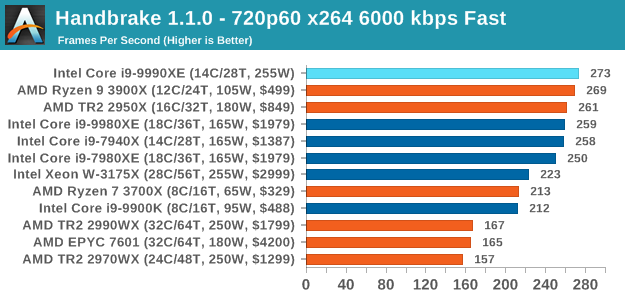
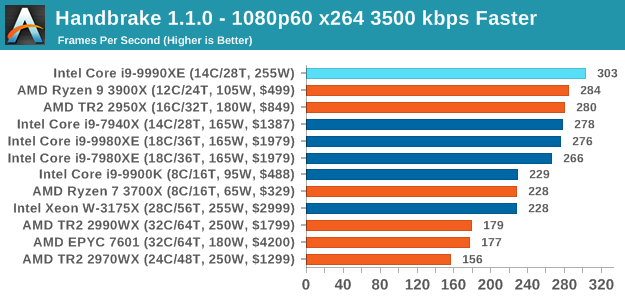
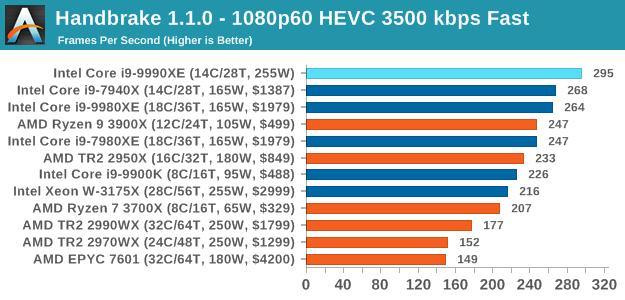
Our encoding tests require a good balance of cores and frequency, and the 5.0 GHz 14-core hardware easily pulls ahead of the 7940X, and shows that having 28 cores isn't always a good thing.
7-zip v1805: Popular Open-Source Encoding Engine
Out of our compression/decompression tool tests, 7-zip is the most requested and comes with a built-in benchmark. For our test suite, we’ve pulled the latest version of the software and we run the benchmark from the command line, reporting the compression, decompression, and a combined score.
It is noted in this benchmark that the latest multi-die processors have very bi-modal performance between compression and decompression, performing well in one and badly in the other. There are also discussions around how the Windows Scheduler is implementing every thread. As we get more results, it will be interesting to see how this plays out.
Please note, if you plan to share out the Compression graph, please include the Decompression one. Otherwise you’re only presenting half a picture.
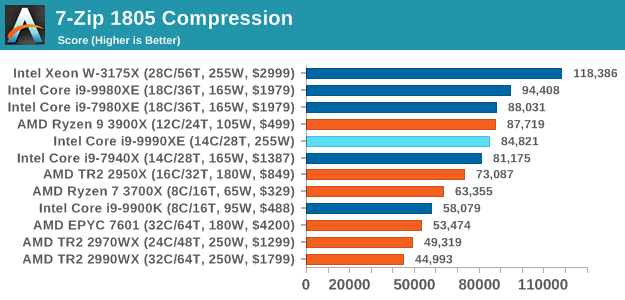
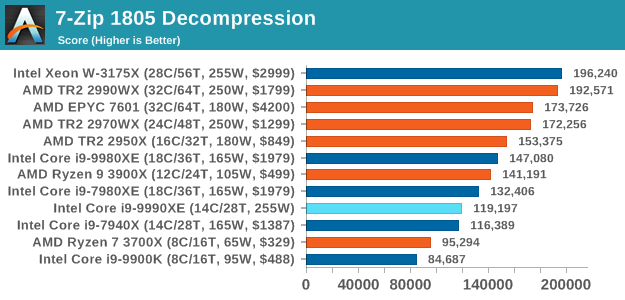

This is where having 28-cores helps, as the extra frequency can't beat some extra cores.
WinRAR 5.60b3: Archiving Tool
My compression tool of choice is often WinRAR, having been one of the first tools a number of my generation used over two decades ago. The interface has not changed much, although the integration with Windows right click commands is always a plus. It has no in-built test, so we run a compression over a set directory containing over thirty 60-second video files and 2000 small web-based files at a normal compression rate.
WinRAR is variable threaded but also susceptible to caching, so in our test we run it 10 times and take the average of the last five, leaving the test purely for raw CPU compute performance.
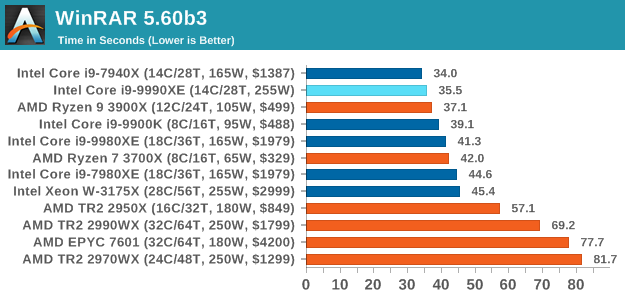
WinRAR is one of our variable threaded tests, so here a mix of cores and frequency helps. Interestingly enough, the 9990XE despite with the higher frequency is slightly slower than the 7940X - this might be a function of the test getting too fast, or the fact that the extra power needed to drive up the cores to peak frequency might be causing additional delays with all the small files.
AES Encryption: File Security
A number of platforms, particularly mobile devices, are now offering encryption by default with file systems in order to protect the contents. Windows based devices have these options as well, often applied by BitLocker or third-party software. In our AES encryption test, we used the discontinued TrueCrypt for its built-in benchmark, which tests several encryption algorithms directly in memory.
The data we take for this test is the combined AES encrypt/decrypt performance, measured in gigabytes per second. The software does use AES commands for processors that offer hardware selection, however not AVX-512.
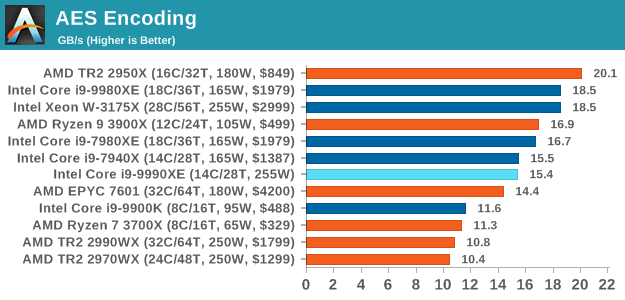










145 Comments
View All Comments
Supercell99 - Monday, October 28, 2019 - link
The democrats have banned LN2 in New York as they have deemed it a climate pollutant.xrror - Monday, October 28, 2019 - link
No they haven't you republican jackass, the Earth's atmosphere is 78% nitrogen.eek2121 - Monday, October 28, 2019 - link
Because after a while, the system breaks down under LN2 cooling. There is such a thing as silicon being too cold, you know. Google intel cold bug, for example.ravyne - Monday, October 28, 2019 - link
Have you seen LN2 cooling? It's not really practical for prolonged use -- you have to keep the LN2 flowing, you have to vent the gasses of the expended LN2, you have to resupply the LN2 somehow.But you're missing the most important constraint of all for high-frequency trading, which is the reason they're building this processor into just 1 rack unit -- these machines aren't running on some remote data center, they're running in a network closet or very small data center probably just a floor or two away from a major stock exchange, in the same building. There is only so much space to be had. The space that's available is generally auctioned and can run well into 5-figures per month for a single rack unit. That's why they're building the exotic 1U liquid cooling in the first place, it'd be much easier to cool in even 2 units (there's even off-the-shelf radiators, then).
edzieba - Thursday, October 31, 2019 - link
These machines are installed in exchange-owned and managed datacentres. "No LN2" as a rule would scupper that concept from the start, but even if it were allowed then you still have the problem of daily shipments of LN2 into a metropolitan centre, failover if a delivery is missed, dealing with large volumes of N2 gas generated in a city centre, etc. Just a logistical nightmare in general.eek2121 - Monday, October 28, 2019 - link
It's impossible to cool a system 24/7 with LN2.DixonSoftwareSolutions - Tuesday, October 29, 2019 - link
I think you probably could do something like that. You would want to run it on a beta system in parallel with your production system for a long time to make sure you had the 99.999999% uptime required. You would have to get pretty down and dirty to make it a 24/7 system. Probably a closed loop LN2 system, and I don't even know what kind of machine is required to condense from gas to liquid. You would also probably want heaters on the other components of the motherboard so that only the die was kept at the target low temp, and other components at the correct operating temp. And you would probably have to submerge the entire thing in some dielectric fluid like mineral oil to prevent condensation from building up. It would be expensive no doubt, but if (m/b)illions are on the line, then why not? Also, before embarking on something like this, you would want to make certain that you had tweaked every last bit of your software, both third party software settings and internally authored code, to minimize latency.willis936 - Monday, October 28, 2019 - link
Judging from your description I would argue that a traditional PC is a horrible choice for such a problem, given the money at stake. They should be spinning custom ASICs that have the network stack and logic all put together. Even going through a NIC across a PCIe bus and into main memory and back out again is burning thousands of nanoseconds.29a - Monday, October 28, 2019 - link
I'm also wondering why they don't create custom silicon for this.gsvelto - Monday, October 28, 2019 - link
They do, not all HFT trading houses use software running on COTS hardware. Depending on where you go you can find FPGAs and even ASICs. However, not all of them have the expertise to move to hardware solutions; many are tied to their internal sofware and as such they will invest in the fastest COTS hardware money can buy.